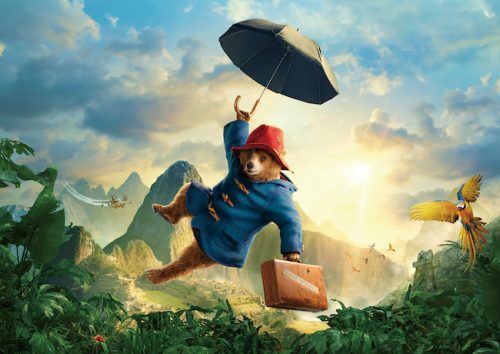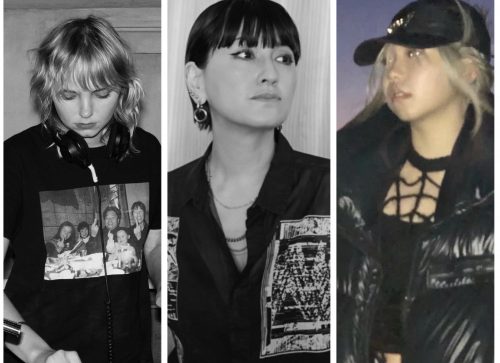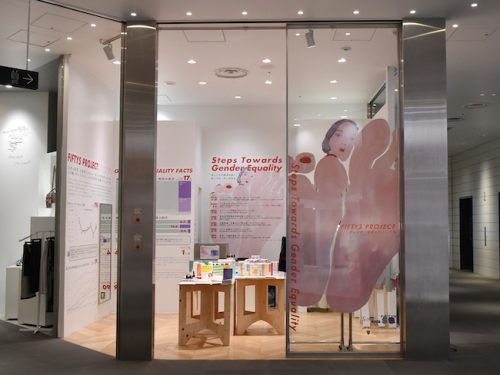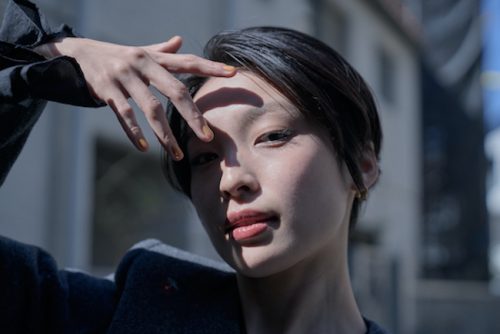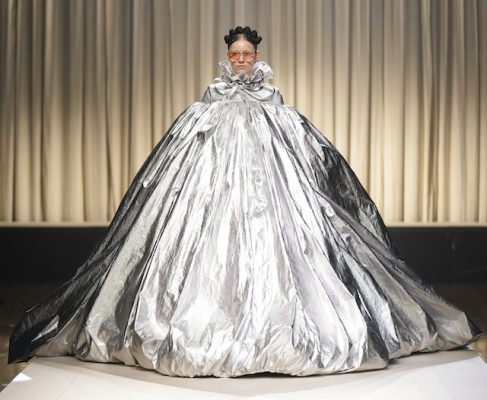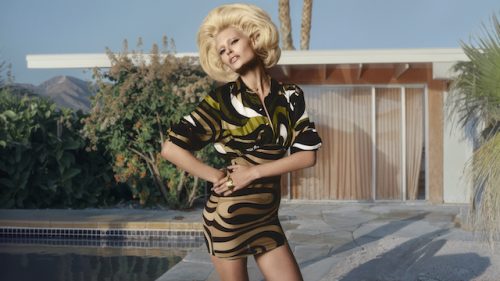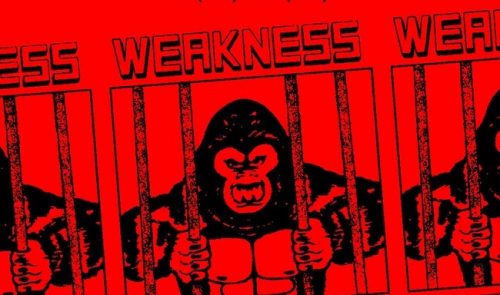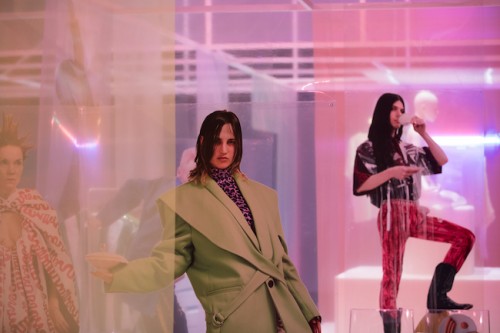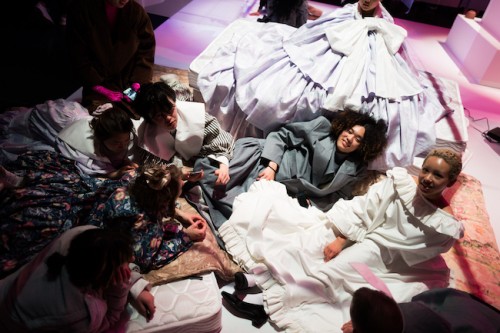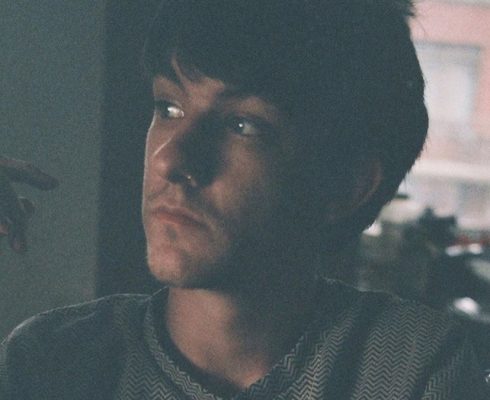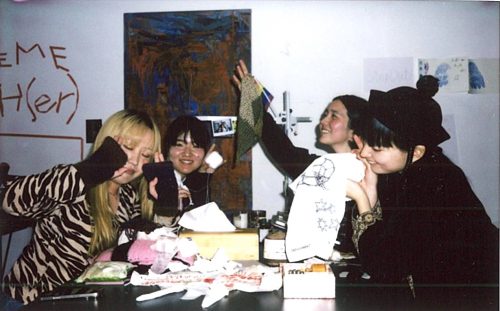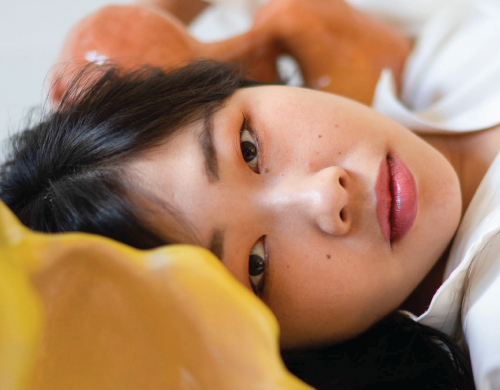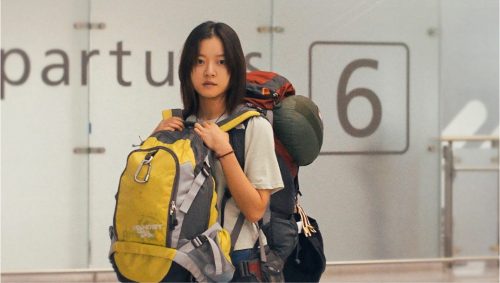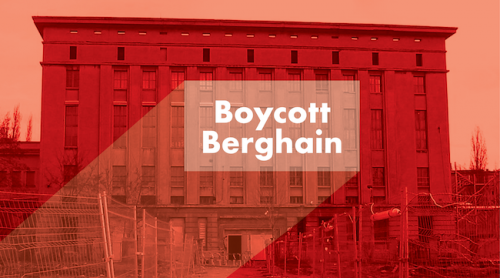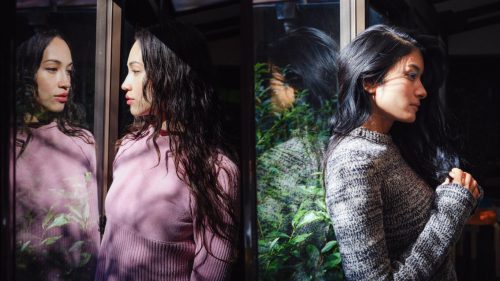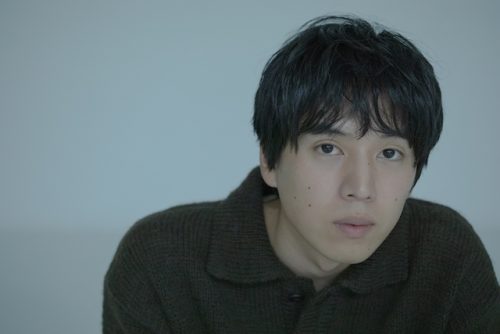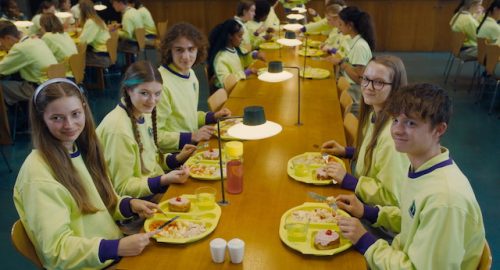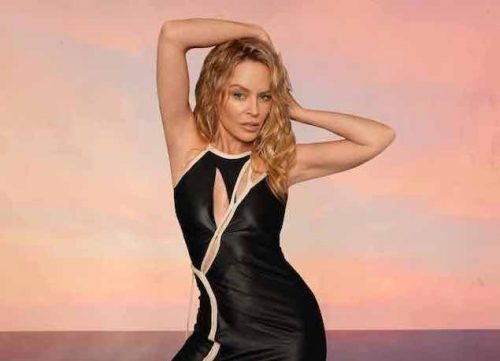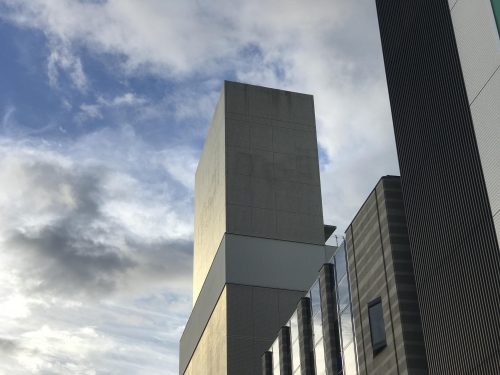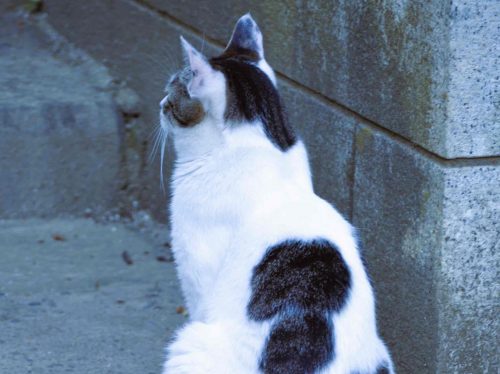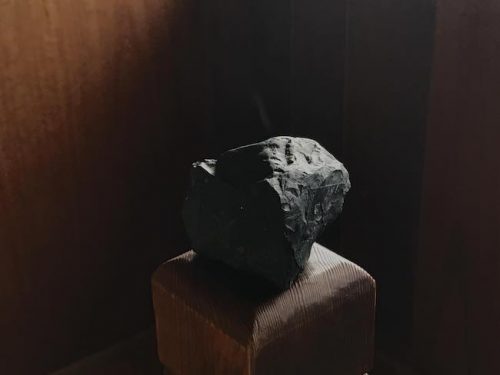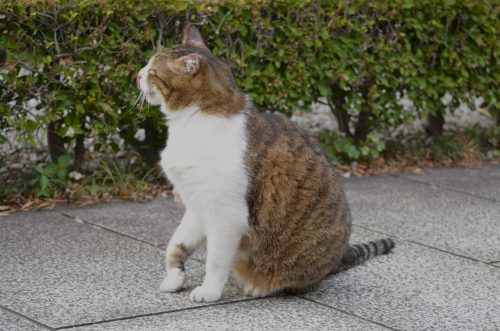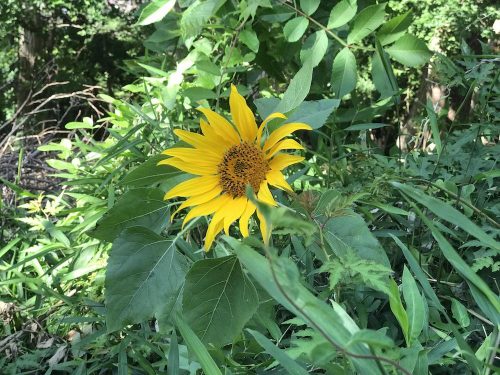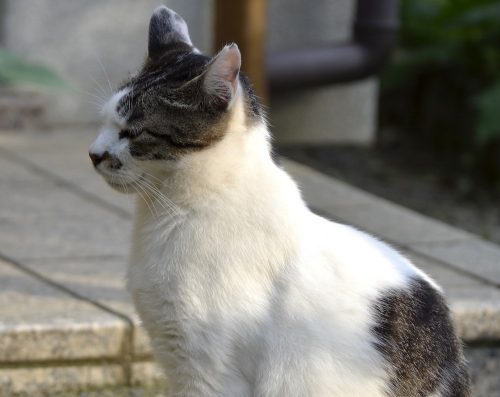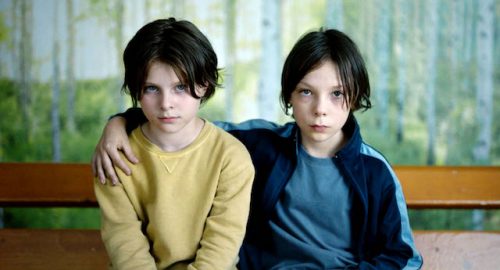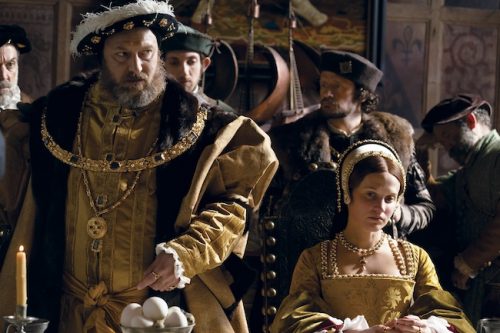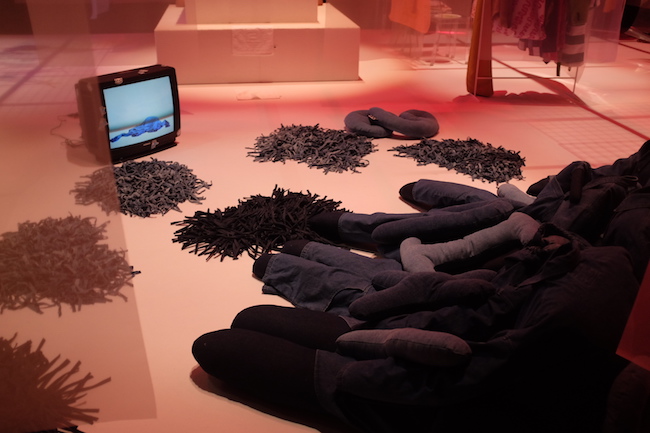
オトナになるという境界線は、公的には”20歳(もうすぐ18歳に引き下げ)”となっているけれど、もちろんその年齢になったからといって突然に精神が成熟するというわけではない。なんなら、20歳を超えてもまだオトナになりきれていな人はたくさんいるようだ。じゃあ一体”オトナ”ってなんなのか。確固とした定義は難しいけれど、自分だけの換えのきかない毎日をしっかりと歩むことの延長線上に、自分なりの答えが見つかるかもしれない。
進路が少しずつ重きを増してきて、身体も気持ちも毎日少しずつ変化する14歳の頃、いま楽しく仕事したり生活している先輩たちはどんなことを考えて、どんなことをしていたんだろう。そんなファイルを作りたいと始まった「14歳」特集に、NYのアーティストたちが参加。「New York New Work(NYNW/2019年3月にルミネゼロで開催されたNYのデザイナーたちによるアートエキシビション)」のため来日を果たした69の匿名(アノニマス)のデザイナーにかわって、デザイン・アシスタントを務めるローラが登場。自由かつコンセプチュアルな服作りで美術館での展示も行う69の真髄と幼少期について語ってくれた。
――今回の展示のコンセプトから教えていただきたいです。
Laura「これは家族を表現したものです。頭がないのですが、それはそんなに大事じゃないから(笑)。頭が無いことによって単にお互いを支え合っている物体に見せることができるでしょう? さらにUNITYという言葉により一体感を強調して、同じデニムのウォッシュを着せて、繋がっているように見せました。家族で観ているテレビの内容は人間の元をだどるようなもので、後にダンスになっていくんです。心地良い空間に招くというコンセプトでこうしたものを作りました」
――テレビに映された宇宙的な映像は、家族で観るものとしては変わっていておもしろいですね。
Laura「私たちはみんな、ここから来たのかもしれません(笑)。そういう遊び心もあります」
――ああ、これは地球じゃないかもという。
Laura「ええ、それかもしかしたら私達が頭の考えをなくした状態が反映されているのかも。日本に来てから侍の美術展に行って、腹切(ハラキリ)という腹部に集中する行為についてお話を聞いたのがとても新鮮でした。西洋ではよく頭が人間を作るものだという意識があるけど、本当はお腹や身体が作っているのだと思います。身体で物事を感じることも大切です。そうした意味も含まれているのかもしれないですね」
――そうした日本のものからインスピレーションを得る前の段階での着想はどんなものでしたか?
Laura「腹切は後から繋がりましたが、元は頭でなくて体で居心地の良さを体験できる空間を作ることを考えていました。自分もそこでうずくまりたくなるような場所ですね。誰かにハグをされて安心できるような場所」
–Would you please tell us about your concept for this exhibition?
Laura : This is a family. They’re without heads because that’s not so important, haha. You know, maybe our minds are trash anyway. It also lets them be just figures. They’re taking in comfort and each other and supporting and holding each other up to sit. The letters here are “U-N-I-T-Y”, unity. We made it so they would each wear the same wash to give a connectedness. They’re watching this, and it feels a little bit like the origin of stuff. It later goes into a dance. It’s meant to be comfortable and inviting.
–It’s an interesting choice of entertainment for a family.
Laura : But maybe they each came from this. It’s also meant to be super playful.
–This might not be Earth or humans? It may be something else?
Laura : Or maybe it’s an expression of us without being attached to our mindfulness. I was sharing with Morimoto that I arrived and I went to a museum about samurais, and I took great pleasure in hearing how harakiri is from the stomach. The mind is not the center of who we are, and the center is in the stomach. I think that in Western culture, we put a lot of value in our thoughts and thinking but maybe it’s important to feel and enjoy.
―ーWhat was the base of your inspiration? Like the harakiri, are you sometimes inspired by Japanese culture?
Laura : The harakiri came later, but the base was simplicity and for it to be fun and cozy – I feel like I want to climb in there and go lie down. It looks like somewhere where I would be able to get a hug.
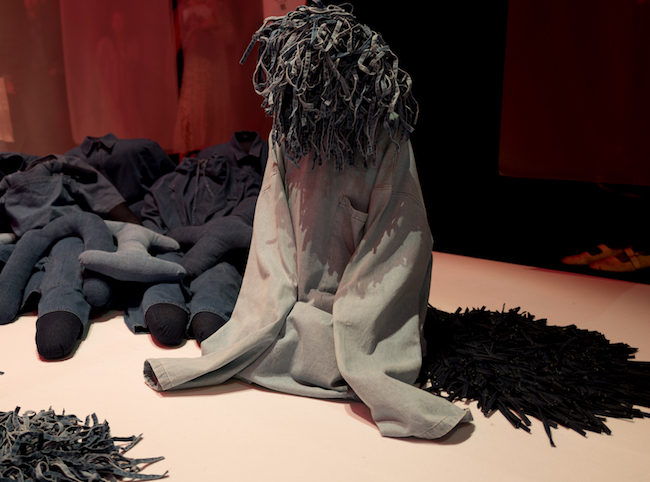
――69は見る人によっていろんな解釈ができるような自由な服作りが特徴ですが、制作時に念頭に置いていることは何でしょうか?
Laura「自由と柔軟性は私のアートのコンセプトであり、私にとってとても大事なことです。それを理解してもらえて嬉しいです。私は短い人生の中でどうやってお互いに優しくし、心地よく、暖かく接するかを考えた結果の表現をしているんです。身体というのは私たちの存在の中で一番制限を与えているもの。ファッションはどうしても完璧な身体を象っているものが多いけど、私は個々の身体に合った、その人が着たら自信がつくようなものを作る努力をしています」
―ー昨今、特に必要であり重要な考えだと思います。今はいろんな物事が混沌としてる状態で、洋服も含めて向き合う時機だと感じています。ここに至るまでの道のりについてもきかせください。14歳の頃はどのような生活をしてて、どんなことを考えていましたか?
Laura「14歳は身体の変化が多い大事な時期だったと思います。身体が女性っぽくなっていくのは若い人にとっては理解しにくいですよね。私もそうでした。内面に関していえば、ファッションとアートをやりたいとその頃から思っていました」
――そのためにどのような努力をしてましたか?
Laura「14歳で既にファッションデザインの勉強をしていました。このブランドではメインのデザイナーではないけれど、デザイナー自身もおそらく服は衣食住として必要なものというだけでなく、一番最初に目につく表現法だという認識だと思います。14歳は身体も変わってくるけど、自分を他人にどう表現したいかわかってくる時期でもあると思います。自分がクリエイティヴなものを通して表現しなければ気が済まない人ならば、朝に服を選ぶことからその表現は始まると思いますね」
――日本だと制服が多いので、その制服の中でいかに工夫するかが大事でした。
Laura「この展示はある意味、制服と関係があると思います。他の作品を見渡すと色鮮やかだったりするけれど、ここはデニムばかりで、たまにウォッシュが違うものを置いているくらい。もしかしたら若い頃に制服を着なくてはいけないような制限されていた感覚は、シンプルなものを選べる自由を与えてくれていると思うこともできるのかもしれません。選んでる時間を無駄にしないし、イメージも簡単につきます。使う素材はデニムのみだけど、そうすることによって服のラインや形やフォームに集中できるんです」
――思い返してみて、何気なく覚えている14歳のエピソードはありますか?
Laura「海外のファッション誌を見てとてもセクシーだなと思ったことを覚えています。その前から服に興味はありました。母の親友がいつも派手な服を着てて、彼女のお下がりをもらっていました。20年代、30年代、40年代からのものばかりでもちろん私には大きすぎだったけど、いただいたものを触り、どう作られているのかを探るのが趣味になりました。それが始まりだったのかもしれません」
――最後に今後の予定でシェアできるものがあれば教えてください。
Laura「いつか東京に店舗を開きたいです。予定というより、私の夢ですね」
–I think that you make art that allows for each person who views it to have a different adaptation of its meanings. The freedom that your garments project is also characteristic of your work. What are you aware of when you are constructing and creating such garments?
Laura : It’s very important to me. Thank you for understanding that it’s meant to be for anyone. I think that this life is very short and it’s a small expression, so how do we be gentle, comfortable, and feel warm?
Also for me, the body is the most limiting part of this existence. Some fashion is about the perfection of the body, but this is about being in the body and feeling good about it.
–It’s especially important in this day and age. Everything tends to be jumbled together these days, and there is a need to sort that out, including concepts of fashion. Anyways, we are doing our April issue on what artists thought or felt when they were 14 years old. What was your experience like back then?
Laura : Personally, I think 14 was really important for the body because suddenly there’s a new expression of being a woman, which can be confusing. I knew that I wanted to work in fashion and art.
–Is there something you were resilient in doing to become who you are as a fashion designer today?
Laura : I studied fashion design in school at 14. But I’m not the primary designer here, I assist. But I think she would also say that clothes, we require. It’s one of the first forms of expression. I think that happens also at 14 that suddenly you’re saying “okay, I’m my own person. How do I let everyone else know what I think about myself?” You want others to understand who you are. I don’t know if there’s even a choice. If you’re someone who needs to express yourself creatively, then you have to start in the morning by putting clothes on.
–In Japan, most students that age have uniforms so it’s especially important to express yourself within the limited amount of freedom you get.
Laura : Yeah, it’s funny because there is an aspect to this that is very much like the uniform. Because if you look around, you see patterns and colors but here it’s not. Sometimes we change the wash, but what might have felt like a constriction when you were young and in a uniform also for me now feels like a freedom, having simplicity in what I choose so that I’m not spending too much time deciding. You can sculpt the image simply. The textile will always be the same for us. This allows for more focus on the line, shape or form of the garment.
–Was your family supportive of you becoming a fashion designer?
Laura:Yes.
–You’re very lucky. Was there a particular episode that you remember from when you were 14?
Laura : I remember finding foreign fashion magazines and thinking they were very sexy, haha. But before that, my mother’s best friend had crazy clothes. So she would just give away her old things from the 20s, 30s and 40s which were all too big on me. But that’s when I wanted to touch and feel the fabrics and figure out how they work together. That felt very exciting, and that felt like an introduction.
–Are there any news or future plans you would like to share with us?
Laura : I mean I would love to have a store in Tokyo… I don’t know how. But I would love that.
69 (シックスティーナイン)
2011 年から老若男女、全ての肌 の色の人たちのために服を作りながら、デザイナーは匿名を貫いているロサンゼルス出身のブランド。2018 年にその回顧展を MOCA 美術館にて開催している。 フォルムを様々な体の形に作ってもらう、ゆったり目の服。自由でおもしろおかしいライフスタイルに賛 同するコアなファンは多い。
IG: @69us
sixty-nine.us
